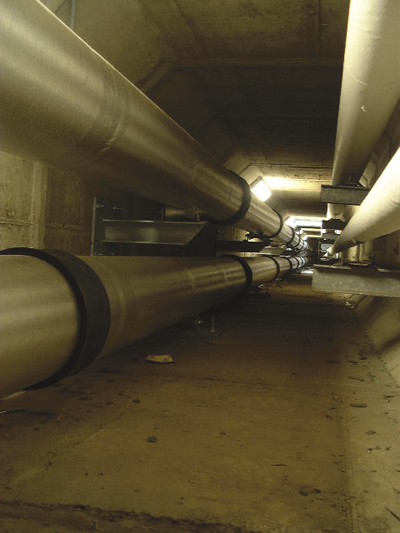An underground look at Kent State

Submitted Photo.
October 6, 2011
Students walking to class down the Esplanade may notice hot air blowing up on their legs from under the grates. Some may have even looked down into the grates to see a person wearing a hardhat walking below them.
That’s because, like most large universities, Kent State has an underground tunnel system.
Michael Bruder, director of design and construction, said the system acts as a central distribution center.
The first tunnel was built in the 1910s, and as the campus grew, so did the intricate system of piping, running near and branching off to at least 75 percent of the buildings on campus.
“They are used to distribute all of our central utilities, which include electricity, campus data and telephone distribution and our steam distribution system,” Bruder said. “We generate steam at our power plant then push it all around campus for heating systems, domestic hot water and, in some cases, to provide cooling. We do have some domestic waterlines but not too many.”
Bruder said the utilities are stored in the tunnels, so they will last longer and not corrode. It also allows maintenance personnel to keep an eye on portions, ensuring everything is working properly or that problems are quickly fixed.
“We have preventative maintenance that goes down (in the tunnels) every day,” said Bob Winkler, assistant director of University Facilities Management at Kent State. “A lot of the common repairs are maintaining insulation, so we’re not overheating the tunnels.”
When the maintenance workers walk the tunnels, Bruder said they could venture anywhere from “stoop tunnels,” which are 5-feet high and 5-feet wide, to the biggest tunnel, which is 10-or 11-feet high and 9-feet wide.
The tunnel’s size depends on the piping system inside. As the tunnel gets farther away from the power plant, the pipes get smaller because less steam is being delivered.
“In general, they are considered more energy efficient,” Bruder said. “The first time costs of other systems can be less expensive, but they consume more energy and cost more in the long term. We’re trying to be efficient, save energy and therefore, save money to help everybody make college as inexpensive as possible.”
Some people may picture an underground tunnel system to be a cave-like walkway with mud walls.
However, Bruder said the tunnels at Kent State look more like the turnpike tunnels that go under mountains.
“Most of it is just concrete,” Winkler added. “They’re very narrow in some sections because there are so many utilities inside them and very warm from the steam.”
Winkler also said areas under the sidewalk grids can let in precipitation – and cigarette butts.
“Most of the areas are extremely dark,” Winkler said. “You always take an extra flashlight with you in case the lights go out on you. Sometimes, there’s 300 feet you have to travel before you can get back out again or maybe even longer.”
As a safety precaution, Winkler said his employees are only allowed in the tunnels if they travel in pairs, wear hardhats, and carry a flashlight and a two-way radio.
“It’s not a safe place if you don’t have the safety training or understanding of where you’re at,” Bruder said. “The steam that runs through those pipes is over 300 degrees Fahrenheit, and the high voltage cables are at 13,000 volts.”
For safety reasons, the only authorized personnel are allowed in the tunnels, including maintenance workers, university architects, engineers and police officers or EMS personnel in emergency situations.
The lock and security systems in the tunnels do keep possible intruders out, but Michquel Penn, community resource officer at the Kent State Campus Police, said she will sometimes catch a student who has snuck in the tunnels.
“Those areas are marked restricted for many reasons,” Penn said. “It’s really a safety concern, so they shouldn’t be down there.”
If students are caught in the tunnel system, Penn said they can receive anything from a warning to a criminal trespassing charge. Criminal trespassing is a misdemeanor of the fourth degree, which entails fines of up to $250 and jail time for up to 30 days.
Penn said students can also be sent to the Office of Student Conduct in lieu of going to criminal court. In this case the student will have a hearing with two faculty members and one student and will receive disciplinary action from the university if found responsible.
“Most importantly: Stay out of them,” Winkler warned. “They’re dangerous for people who aren’t prepared and don’t have the proper protective clothing or equipment. It’s not worth trying to sneak in. If anyone ever saw a hatch left open or a door unlocked, please call our maintenance dispatch (at 330-672-2345) so we can get it secured right away.”
Contact
Rachel Jones at [email protected].























